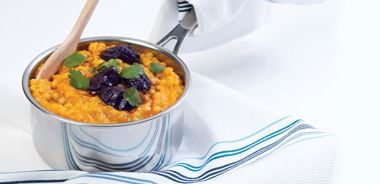Spiced Israeli Couscous with Prunes and Ginger

This is a great vegetarian dish, or it can be paired with meats such as lamb, rabbit, or poultry. Israeli couscous is a small, round, toasted semolina pasta that should not be confused with the tiny yellow North African couscous. Sauces stick to it perfectly!
1 cup (250 mL) Israeli couscous
2 cups (500 mL) vegetable stock
2 large organic carrots, peeled and finely chopped
1 tsp (10 mL) unsalted butter
1 cup (250 mL) prunes
1 tsp (2 mL) honey
1 cardamom pod
2 Tbsp (30 mL) extra-virgin olive oil
1 onion, finely chopped
4 cloves garlic, peeled and sliced
1 tsp (5 mL) ginger, finely chopped
1/2 tsp (2 mL) cumin seeds
1 pinch dried chilies
Salt and pepper
Cilantro to garnish
Toast couscous in a 325 F (160 C) oven until lightly browned.
Heat vegetable stock to a simmer.
In small saucepan add carrots, butter, pinch of salt, and just enough water to cover carrots. Cook at high heat until carrots are soft enough to break easily with the back of a spoon, then purée and reserve.
Poach prunes in 2 cups (500 mL) water with honey and cardamom until soft.
In medium saucepan sweat onion, garlic, and ginger in olive oil (over low heat and covered with a tight-fitting lid). Add cumin seeds, chilies, and couscous. Add enough simmering stock to cover the couscous and gently simmer, stirring occasionally. As the liquid reduces, keep adding enough to cover and cook until just tender. Season to taste.
To serve, combine couscous and carrot purée. Top with poached prunes and cilantro.
source: "Prunes", from alive #342, April 2011




